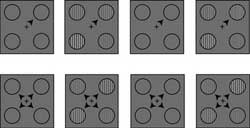Measuring attention to detail

A schematic diagram of the contrast discrimination task, showing the focal cue trial (top row) and the distributed cue trial (bottom row). The contrast within the top right circle increases from the first interval (second column) to the second interval (fourth column). The third column is the interstimulus interval. Copyright : 2011 Elsevier Inc.<br>
Our ability to ignore some, but not other stimuli, allows us to focus our attention and improve our performance on a specific task. The ability to respond to visual stimuli during a visual task hinges on altered brain processing of responses within the visual cortex at the back of the brain, where visual information is first received from the eyes. How this occurs was recently demonstrated by an international team of researchers led by Justin Gardner at the RIKEN Brain Science Institute in Wako.
In a contrast discrimination task, the researchers showed three observers a stimulus of a group of four circles, each containing grey and white bars that created stripes of different contrasts. After a short pause, the researchers showed the circles again, but the contrast within one of the circles was different. The observers were instructed to choose which group of circles contained the higher contrast.
In ’focal cue trials’, an arrow directed the observers’ attention to a particular circle. In ‘distributed cue’ trials’, four arrows directed their attention diffusely, across all four circles. Gardner and colleagues found that the observers’ performance was better in the focal cue trials.
Using a magnetic resonance imaging (MRI) scanner, the research team was able to map the precise location within the visual cortex that was activated by the visual information within each of the four circles. During the contrast discrimination task, Gardner and colleagues could therefore measure the observers’ visual cortex activity elicited by the stimuli. In this way, they could correlate brain activity in the visual cortex with the observers’ attention and their choice of contrasting circles.
Visual cortex responses tended to be largest when the observers were paying attention to a particular target circle, and smallest when they were ignoring a circle. The researchers determined that the largest visual cortex responses to the stimuli guided the eventual choice of each observer, leading to enhanced performance on the visual task.
“We used computational modeling to test various hypotheses about how attention affects brain processing of visual information to improve behavioral performance,” explains Gardner. “We concluded that the observers’ attention causes their brains to select the largest cortical response to guide contrast choice, since we found that an ‘efficient selection’ model best explained the behavioral and fMRI data,” he says.
If the findings extend to other senses, such as hearing, researchers may begin to understand how humans make sense of a perceptually cluttered world.
The corresponding author for this highlight is based at the Gardner Research Unit, RIKEN Brain Science Institute
Media Contact
All latest news from the category: Life Sciences and Chemistry
Articles and reports from the Life Sciences and chemistry area deal with applied and basic research into modern biology, chemistry and human medicine.
Valuable information can be found on a range of life sciences fields including bacteriology, biochemistry, bionics, bioinformatics, biophysics, biotechnology, genetics, geobotany, human biology, marine biology, microbiology, molecular biology, cellular biology, zoology, bioinorganic chemistry, microchemistry and environmental chemistry.
Newest articles

Properties of new materials for microchips
… can now be measured well. Reseachers of Delft University of Technology demonstrated measuring performance properties of ultrathin silicon membranes. Making ever smaller and more powerful chips requires new ultrathin…

Floating solar’s potential
… to support sustainable development by addressing climate, water, and energy goals holistically. A new study published this week in Nature Energy raises the potential for floating solar photovoltaics (FPV)…

Skyrmions move at record speeds
… a step towards the computing of the future. An international research team led by scientists from the CNRS1 has discovered that the magnetic nanobubbles2 known as skyrmions can be…





















